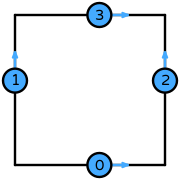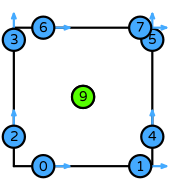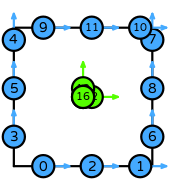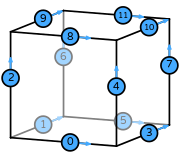Trimmed serendipity H(curl)
Click here to read what the information on this page means.
| De Rham complex families | \(\left[S_{2,k}^\square\right]_{1}\) or \(\mathcal{S}^-_{k}\Lambda^{1}(\square_d)\) |
| Degrees | \(1\leqslant k\) where \(k\) is the Lagrange superdegree |
| Polynomial subdegree | \(k-1\) |
| Polynomial superdegree | \(k+d-2\) |
| Lagrange subdegree | \(\operatorname{floor}((k+d-1)/(d+1))\) |
| Lagrange superdegree | \(k\) |
| Reference elements | quadrilateral, hexahedron |
| Polynomial set | \(\mathcal{P}_{k-1}^d \oplus \mathcal{Z}^{(40)}_{k} \oplus \mathcal{Z}^{(41)}_{k}\) (quadrilateral) \(\mathcal{P}_{k-1}^d \oplus \mathcal{Z}^{(42)}_{k} \oplus \mathcal{Z}^{(43)}_{k} \oplus \mathcal{Z}^{(44)}_{k} \oplus \mathcal{Z}^{(45)}_{k} \oplus \mathcal{Z}^{(46)}_{k}\) (hexahedron) ↓ Show polynomial set definitions ↓ |
| DOFs | On each edge: tangential integral moments with an degree \(k-1\) dPc space On each face: integral moments with an degree \(k-3\) vector dPc space, and integral moments with \(\left\{\nabla(p)\middle|p\text{ is a degree \(k-1\) monomial}\right\}\) |
| Mapping | covariant Piola |
| continuity | Components tangential to facets are continuous |
| Categories | Vector-valued elements, H(curl) conforming elements |
Implementations
This element is implemented in FIAT and Symfem .↓ Show implementation detail ↓Examples
| quadrilateral degree 1 |  (click to view basis functions) |
| quadrilateral degree 2 |  (click to view basis functions) |
| quadrilateral degree 3 |  (click to view basis functions) |
| hexahedron degree 1 |  (click to view basis functions) |
| hexahedron degree 2 |  (click to view basis functions) |
| hexahedron degree 3 |  (click to view basis functions) |
References
- Cockburn, Bernardo and Fu, Guosheng. A systematic construction of finite element commuting exact sequences, SIAM Journal of Numerical Analysis 55(4), 1650–1688, 2017. [DOI: 10.1137/16M1073352] [BibTeX]
- Gillette, Andrew and Kloefkorn, Tyler. Trimmed serendipity finite element differential forms, Mathematics of Computation 88, 583–606, 2019. [DOI: 10.1090/mcom/3354] [BibTeX]
- Arnold, Douglas N. and Logg, Anders. Periodic table of the finite elements, SIAM News 47, 2014. [www.siam.org/publications/siam-news/issues/volume-47-number-09-november-2014/] [BibTeX]
- Cockburn, Bernardo and Fu, Guosheng. A systematic construction of finite element commuting exact sequences, SIAM journal on numerical analysis 55, 1650–1688, 2017. [DOI: 10.1137/16M1073352] [BibTeX]
DefElement stats
| Element added | 07 October 2021 |
| Element last updated | 16 October 2024 |